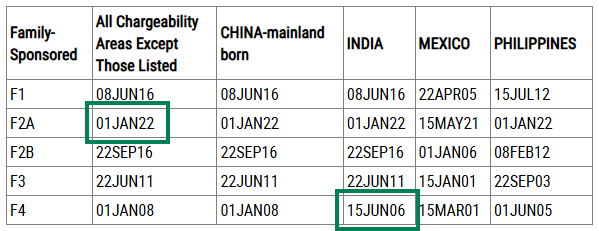Family-Based Green Cards
I would love to help your family navigate the green card application process.

Family Members of U.S. Citizens
U.S. citizens may sponsor more their spouse, children, parents, and siblings for green cards. Spouses, parents, and unmarried children under age 21 qualify as “Immediate Relatives,” which provides a faster path to a green card. The process takes longer for parents, siblings, and older or married children because there is a wait list.
The first step in the green card process is filing an I-130 petition with U.S. Citizenship and Immigration Services (USCIS) to prove the qualifying family relationship.
The second step is the green card application. The process for this varies depending on the circumstances. Those who are already in the United States may qualify to “adjust status” and get a green card while remaining in the United States by filing an I-485 application. Those outside the United States or not qualified to adjust status must apply for an immigrant visa at a U.S. consulate, then use that visa to enter and receive a green card.
There is no wait list for immediate relatives (spouses, parents, and unmarried children under 21). They may either file an I-485 application together with their I-130 petition or start the immigrant visa process right after the I-130 is approved.
Other family members of U.S. citizens fall under preference categories and must wait for their green card to become available under the visa bulletin (described below). Family members who are sponsored for green cards under these preference categories may also get green cards for their spouse and children as derivative applicants.
Visas for Fiancés and Spouses of U.S. Citizens
K-1 Visas for Fiancés of U.S. Citizens: When a U.S. citizen is engaged to someone living in another country, they may apply for a K-1 visa for the foreign fiancé to travel to the United States to get married within 90 days of arrival. Any children of the K-1 visa applicant can get K-2 visas to travel with their parent. The K-1 and K-2 visa holders can then adjust status to become U.S. permanent residents after the wedding.
K-3 Visas for Spouses of U.S. Citizens: Spouses of U.S. citizens who are waiting for approval of an I-130 petition can get a K-3 visa to join their spouse in the United States instead of waiting for consular processing.
Family Members of U.S. Permanent Residents (Green Card Holders)
U.S. permanent residents may sponsor their spouse and unmarried children (any age) for green cards. Children of the spouse and unmarried children are eligible for green cards as derivative applicants. Permanent residents may not sponsor their parents, siblings, or married children unless they first become U.S. citizens.
The same two-step process described above is also used here. First, the U.S. permanent resident files an I-130 petition with USCIS to sponsor their family member and prove the family relationship. Family members must wait until the visa bulletin allows them to proceed with the second step: applying for a green card through adjustment of status or an immigrant visa.
Understanding the Visa Bulletin
As described above, family members of U.S. permanent residents and some family members of U.S. citizens (those not qualifying as immediate relatives) must wait until the visa bulletin allows them to file their green card application. This is because the United States limits the number of green cards available each year for certain categories. The visa bulletin, which is published monthly by the U.S. Department of State, determines when people may apply for a green card.
The Dept. of State’s website provides the visa bulletin for the current month and upcoming month. The visa bulletin covers different green card types. Here, we are looking at the family-sponsored preference categories.
The first step is determining which family-sponsored preference category applies:
Relatives of U.S. Citizens:
- First (F1): Unmarried sons and daughters of U.S. citizens (NOTE: unmarried children under 21 years old are immediate relatives) (and their children as derivative applicants)
- Third (F3): Married sons and daughters of U.S. citizens (and their spouse/children)
- Fourth (F4): Brothers and sisters of U.S. citizens (and their spouse/children)
Relatives of U.S. Permanent Residents:
- Second (F2A): Spouses and unmarried children of U.S. permanent residents (under age 21) (and their children)
- Second (F2B): Unmarried sons and daughters (age 21+) of U.S. permanent residents (and their children)

People become eligible to get a green card their Final Action Date moves after their “priority date.” Someone’s “priority date” is the date an I-130 petition was filed with USCIS on their behalf, which is shown on their I-130 approval notice. In the examples above, if the Indian sister (F4) has a priority date of June 16, 2006, then it is very close but not yet current. If the Brazilian spouse’s (F2A) priority date is December 30, 2021, then it is current.
The visa bulletin has two similar charts the family-based preference categories that are read the same way. The Final Action Date chart indicates when someone may receive their green card. The other is the “Dates for Filing” chart, shows when someone may start the application process. The Dates for Filing chart is always used to determine when people outside the United States using consular processing may start the immigrant visa application process. For adjustment of status from within the United States, USCIS decides each month (on its website) which chart is used for when people may file their I-485 applications.
As you can see by the visa bulletin dates, the wait to get a green card can be a very long. Nevertheless, families should begin the process sooner than later to lock in the priority date.
Victims of Domestic Violence
Getting a family-based green card typically requires the sponsorship of a U.S. citizen or lawful permanent resident. However, under the Violence Against Women Act (VAWA), spouses, children, and parents who are victims of abusive U.S. citizens and permanent residents may self-petition for a green card without needing the sponsorship of the abuser. If this applies to you, we can help you through this process without needing anything from the abuser.
